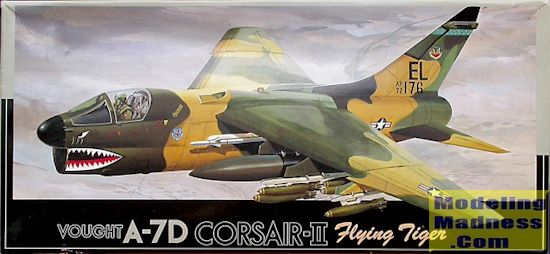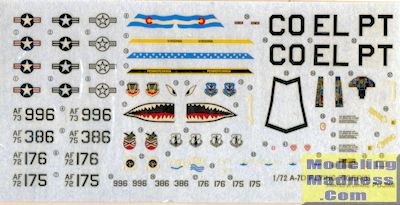
Fujimi 1/72 A-7D Corsair II
| KIT #: | F-11 |
| PRICE: | It was about $15 when it was new in 1986. |
| DECALS: | Five options |
| REVIEWER: | Scott Van Aken |
| NOTES: |

| HISTORY |
In 1962, United States Navy began preliminary work on VAX (Heavier-than-air, Attack, Experimental), a replacement for the A-4 Skyhawk with greater range and payload. A particular emphasis was placed on accurate delivery of weapons to reduce the cost per target. The requirements were finalized in 1963 and in 1964 the Navy announced the VAL (Heavier-than-air, Attack, Light) competition. Contrary to USAF philosophy, which was to employ only supersonic fighter bombers such as the F-105 Thunderchief and F-100 Super Sabre, the Navy felt that a subsonic design could carry the most payload the farthest distance. One story illustrated that a "slow fat duck" could fly nearly as fast as a supersonic one, since carrying dozens of iron bombs also restricted its entry speed, but a fast plane with small wings and an afterburner would burn up a lot more fuel. To minimize costs, all proposals had to be based on existing designs. Vought, Douglas Aircraft, Grumman, and North American Aviation responded. The Vought proposal was based on the successful F-8 Crusader fighter, having an identical configuration, but more short and stubby, with a rounded nose. It was selected as the winner on 11 February 1964, and on 19 March the company received a contract for the initial batch of aircraft, designated A-7. In 1965 the aircraft received the popular name Corsair II, after Vought's highly successful F4U Corsair of World War Two.
Compared to the F-8 Crusader fighter, the A-7 had a shorter, broader fuselage. The wing was made larger, and the unique variable incidence wing of the F-8 was deleted. To achieve the required range, A-7 was powered by a Pratt & Whitney TF30-P-6 turbofan producing 11,345 lbf (50.5 kN) of thrust, the same innovative combat turbofan produced for the F-111, but without the afterburner needed for supersonic speeds. Turbofans achieve more efficiency by moving unburned air at a lower velocity.
The aircraft was fitted with an AN/APQ-116 radar which was integrated into the ILAAS digital navigation system. The radar also fed a digital weapons computer which made possible accurate delivery of bombs from a greater stand-off distance, greatly improving survivability compared with faster platforms such as the F-4 Phantom II. It was the first US aircraft to have a modern heads-up display, now a standard instrument, which displayed information such as dive angle, airspeed, altitude, drift, and aiming reticle. The integrated navigation system allowed for another innovation -- the projected map display system (PMDS) accurately showed aircraft position on two different map scales.
The A-7 enjoyed the fastest and most trouble-free development period of any American combat aircraft since the second world war. The YA-7A made its first flight on 27 September 1965, and began to enter Navy squadron service late in 1966. The first Navy A-7 squadrons reached operation status on 1 February 1967, and began combat operations over Vietnam in December of that year.
Secretary of Defence Robert McNamara prodded the Air Force to adopt not only the hugely successful F-4 Phantom II, but also the Navy's A-7 Corsair as a low cost follow-on to F-105s until the troubled F-111 came online. The Air Force ordered the A-7D with a fixed high speed refueling receptacle behind the pilot optimized for the KC-135's flying boom rather than the folding long probe of Navy aircraft. They opted for the M61 Vulcan gatling gun rather than the twin single-barrel 20 mm cannon, and changed to the Allison TF41-A-1 engine, which was a licenced version of the British Rolls-Royce Spey. The TF41-A-1 engine produced 14,500 lbf (64 kN) of thrust. Later Navy versions would adopt this gun and engine.
| THE KIT |
 Fujimi
has a rather checkered history when it comes to its model kits. They are either
superb or they are really bad when it comes to fit. Thanks to the previous
importer (MRC), they were also priced so high that they sat on shelves for
years. Just shows that greed does curtail sales.
Fujimi
has a rather checkered history when it comes to its model kits. They are either
superb or they are really bad when it comes to fit. Thanks to the previous
importer (MRC), they were also priced so high that they sat on shelves for
years. Just shows that greed does curtail sales.
The Fujimi A-7 series is, in the opinion of most, the finest 1/72 Corsair II kits done. They have superbly done, crisp engraved detailing and super thin clear bits. So thin that your editor has broken more windscreens than he'd care to admit. Thanks to non-existent customer service from the importer, none of those parts were ever replaced and I had to make do with the broken bits.
1/72 cockpits are rarely super detailed and Fujimi does provide decals for the instrument panel and side consoles, but those items are also nicely detailed with dial faces and such so you may want to consider paint and dry brushing. A well molded, but rather bare seat is provided along with a nice control stick to round out the cockpit. There is room in the nose for weight and the wise will put some in there just to be sure. As this fuselage is the basis for a number of variants, the intake is separate and the most difficult part to do well. there is a rather good intake trunk, but there is also a seam that runs right down the middle of it, making filling prior to installation a must. Same with the upper section. No compressor face is provided.
Wings can only be displayed extended and the flaps are integral with the wings. Inner pylon holes are pre-drilled, which is fine as the Corsair II was rarely seen without wing pylons. The kit has a separate sprue that is only for the USAF version that includes the proper wheels, dorsal refueling receptacle, nose gear and other land-lubber pieces. Wheel wells are nicely detailed as are the landing gear. One thing about Fujimi A-7s is that they come with racks and weapons. For the A-7D, you have a pair of MERs, a pair of TERs and a pair of wing tanks. Snakeyes are provided for the bomb racks, though it is a rather light load. Sidewinders and rails are also provided.
 Instructions are well done with Gunze paint references.
Unfortunately, the bulk of hints are in Japanese and the minimal English
translations are, well, a bit funny in some cases. There are four markings
options, all in a wraparound scheme. The first one is with the 74 TFS/23 TFW
with a nice shark mouth and full color insignia. Next is a 120 TFS Colorado ANG
plane with low visibility insignia. This aircraft and the 74 TFS plane are in an
SEA wraparound camo. In a similar scheme to the Colorado plane is a Virginia ANG
plane with the 192 TFG. The fourth option is a 146 TFS, Pennsylvania ANG plane in
the later dark green/dark grey wraparound scheme. All the ANG planes have the Pave Penny pod. The decal sheet is nicely
printed and includes instrument panel and side console markings.
Instructions are well done with Gunze paint references.
Unfortunately, the bulk of hints are in Japanese and the minimal English
translations are, well, a bit funny in some cases. There are four markings
options, all in a wraparound scheme. The first one is with the 74 TFS/23 TFW
with a nice shark mouth and full color insignia. Next is a 120 TFS Colorado ANG
plane with low visibility insignia. This aircraft and the 74 TFS plane are in an
SEA wraparound camo. In a similar scheme to the Colorado plane is a Virginia ANG
plane with the 192 TFG. The fourth option is a 146 TFS, Pennsylvania ANG plane in
the later dark green/dark grey wraparound scheme. All the ANG planes have the Pave Penny pod. The decal sheet is nicely
printed and includes instrument panel and side console markings.
| CONCLUSIONS |
I've built several of these kits and can tell you that they build well, though are not slammers. Care needs to be taken during construction and the parts all test fitted before gluing. I note that some of these are now becoming available again after a rather long absence from the shelves and you can still find them at swap meets for reasonable prices. Way back when, Testors reboxed some of these and those are well worth seeking if for no other reason than their superior decal sheet.
| REFERENCES |
Thanks to me for this one.
May 2015
If you would like your product reviewed fairly and fairly quickly, please contact the editor or see other details in the Note to Contributors.